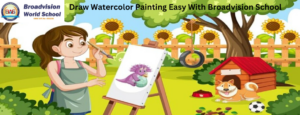Giving your child the best start in life
-
First Floor, 10A Chandos Street London New Town W1G 9LE
Get In Touch
Monday to Friday: 8.30am – 02.00pm
Saturday, Sunday: Close
Email: user@domainname.com
Phone: +44 (0) 207 689 7888

Watercolor Painting is a beautiful art form that allows individuals to express their creativity with ease and fluidity. Unlike other mediums, watercolor painting is known for its forgiving nature, making it an ideal choice for beginners and seasoned artists alike. In this comprehensive guide, we will explore everything you need to know to start your journey into the world of Watercolor Painting.
Watercolor Paints: Get a basic set of paints made specifically for watercolors. These paints come in little tubes or pans and have lots of different colors. It’s good to have a variety so you can mix them to create even more colors. These paints are special because they’re made to mix with water and spread easily on paper.
Watercolor Paper: You need special paper for Watercolor Painting. It’s thicker and tougher than regular paper because it needs to hold up to the water in the paint without getting all wrinkly or falling apart. Look for paper that’s specifically made for watercolors to get the best results.
Paintbrushes: You’ll need some brushes to apply the paint to the paper. Soft-bristled brushes work best for watercolors because they soak up the water and paint nicely. Get a few different sizes so you can paint big areas and tiny details.
Palette: This is where you’ll mix your paint. You can use a special palette, which is like a little tray with sections for each color, or just a clean, flat surface like a plate. Mixing your colors on a palette lets you create all sorts of shades and tones.
Water Containers: You’ll need two containers of water—one for cleaning your brushes and one for mixing with your paint. Make sure to keep them separate so you don’t accidentally get paint in your clean water.
Masking Tape: This is like sticky tape that you can use to stick your paper down to a flat surface while you paint. It helps keep your paper from moving around and gives you nice clean edges on your painting.
Paper Towels: Keep some paper towels handy while you paint. You can use them to blot your brush or soak up any excess water or paint from your paper. They’re also good for wiping off your brushes if you need to switch colors.
Having all these things ready before you start painting will make the process much easier and more enjoyable.
It’s important to create a comfortable and organized workspace before diving into your painting. Make sure you have ample natural light and a flat surface to work on. Keep your paints and brushes within easy reach for quick access.
Wet-on-wet technique
The wet-on-wet technique involves applying wet paint onto a wet surface. This technique creates soft edges and blends colors seamlessly together.
Wet-on-dry technique
In contrast, the wet-on-dry technique involves applying wet paint onto a dry surface. This technique allows for more control and precision, perfect for adding details to your painting.
Dry brushing
Dry brushing is a technique where you use very little water on your brush to create textured and expressive brushstrokes. This technique is great for adding highlights and fine details to your artwork.
Primary, Secondary, and Tertiary Colors: Primary colors are the basic colors that cannot be made by mixing other colors. Secondary colors are created by mixing two primary colors. Tertiary colors are made by mixing a primary color with a secondary color. Understanding how these colors work together helps you create balanced and harmonious compositions.
Color Mixing Tips: Mixing different colors allows you to create new shades and tones. Start with a few primary colors and experiment with mixing them to see what colors you can create. As you practice, you’ll become more comfortable with mixing and expanding your color palette.
Blending colors
Blending colors means mixing them together smoothly. You can do this by applying wet paint next to each other and gently blending them with a clean brush or with water.
Creating gradients
Gradients can add depth and dimension to your paintings. Start with a light wash of color and gradually build up layers to create a smooth transition from light to dark.
Adding texture
Texture adds interest to your paintings. You can experiment with techniques like sprinkling salt on wet paint or using a dry brush to create texture in your artwork.

Landscapes
Animals
Flowers and plants
Abstract designs
Food and drink
Beach scenes
Sunsets
Rainbows
Birds and butterflies
Trees and foliage
Start Small: Begin by trying out simple projects when you’re just starting with watercolor painting. Start with easy subjects like simple shapes or basic objects. As you become more comfortable and confident with your skills, you can gradually try more challenging projects.
Practice Regularly: Make sure to practice your watercolor painting regularly. Set aside some time each day or week to work on your art. The more you practice, the better you’ll become. It’s like exercising a muscle – the more you do it, the stronger you get!
Experiment: Don’t be afraid to try out different techniques and styles with your watercolor painting. Experiment with how much water you use, different brushstrokes, and mixing colors. It’s all about exploring and finding what works best for you. Sometimes, the most unexpected techniques can create beautiful effects!
Learn from Others: Look for inspiration from other artists and tutorials. You can find lots of helpful resources online, like video tutorials or blogs. Don’t hesitate to learn from others and incorporate their tips and tricks into your own painting practice. Learning from others can help you grow as an artist and discover new techniques.
Have Fun: Most importantly, remember to have fun with your watercolor painting! Enjoy the process of creating art and embrace the unpredictability of watercolors. Sometimes, the best results come from happy accidents or spontaneous creativity. So relax, let loose, and enjoy the journey of painting with watercolors!
Watercolor Painting is a versatile and rewarding medium that offers endless opportunities for creativity and self-expression. With the right techniques, inspiration, and practice, beginners can quickly develop their skills and create beautiful works of art. So grab your brushes and paints, and let your imagination soar as you explore the magical world of Watercolor Painting !

Absolutely! Watercolor Painting is a versatile medium that is accessible to artists of all skill levels.
While high-quality materials can enhance your painting experience, you can still create beautiful artworks with affordable supplies.
Mistakes are a natural part of the artistic process. You can often lift off unwanted paint with a clean, damp brush or use masking fluid to preserve areas of your painting.
Knowing when to stop painting is a skill that develops with experience. Trust your instincts and remember that sometimes less is more.
Inspiration can be found everywhere, from nature and everyday objects to other artists’ work. Keep a sketchbook handy to jot down ideas and sketches as they come to you.
Watercolor Painting involves using pigments suspended in water to create vibrant and translucent artworks. The transparency of watercolor allows for layers to be built up gradually, resulting in a luminous and ethereal quality to the paintings.
One of the reasons Watercolor Painting is considered easy is its forgiving nature. Unlike oil or acrylic paints, watercolor can be easily corrected or manipulated even after it has dried. This makes it a perfect medium for beginners who may be apprehensive about making mistakes.
Watercolor Painting is popular among beginners for its forgiving nature and fluidity. Unlike other mediums, watercolor allows for mistakes to be easily corrected and encourages experimentation.
Yes, you can mix different brands of watercolor paints, but be aware that the quality and pigmentation may vary, so it’s best to test them out beforehand.
Stretching your watercolor paper before painting can help prevent buckling. Alternatively, you can use a heavier weight paper or tape down the edges of your paper to minimize warping.
Masking fluid is a liquid latex solution that can be applied to areas of your painting to preserve the white of the paper. Once dry, it can be painted over, and then peeled away to reveal clean, white highlights.
You can add texture to your Watercolor Painting by using various techniques such as salt sprinkling, plastic wrap pressing, or lifting color with a dry brush or sponge.
| easy watercolor painting for beginners | easiest watercolor painting | watercolor techniques for beginners |
| beginner easy watercolor painting | easy aquarelle | water painting for beginners |
| beginner easy watercolor paintings | easy aquarelle painting | aquarelle painting for beginners |
| drawing with watercolor easy | easy painting for watercolor | watercolor art easy |
| easy landscape watercolor painting for beginners | easy water paint | water color painting beginners |
| watercolor painting easy | easy watercolour art | watercolor art for beginners |
| watercolor painting for beginners | water color easy | watercolor artwork easy |
| watercolor for beginners | water color paint easy | watercolour art for beginners |
| water color painting for beginners | water color painting beginner | drawing with watercolor easy |

Draw Watercolor Painting Easy With Broadvision School
Comments are closed